Bratislava is the capital of Slovakia. Bratislava is Slovakia’s political and economic heart and a significant cultural hub.

Bratislava is known for its medieval, baroque, and modernist architecture mix. Apart from its historical attractions, the city boasts an array of modern developments and amenities, including shopping centers, top-notch restaurants, and a lively nightlife scene. It’s a city that seamlessly combines old-world charm with vibrant, modern energy.
Where is Bratislava?
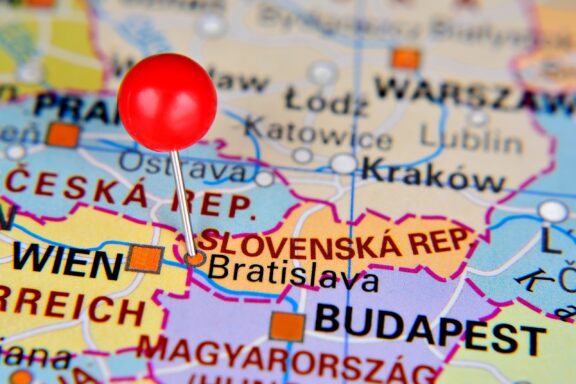
Bratislava is located in southwestern Bratislava Region of Slovakia, near the borders of both Austria and Hungary. It’s positioned along the banks of the Danube River.
In fact, Bratislava is the only national capital in the world that borders two independent countries, Austria and Hungary. The city is about 70 kilometers (43 miles) from Vienna, Austria, and around 200 kilometers (124 miles) from Budapest, Hungary.
History of Bratislava
Bratislava, the capital of Slovakia, has a long and rich history that spans thousands of years. Its strategic location on the Danube River, at the crossroads of ancient trade routes, has shaped its historical significance and development.
Archaeological evidence indicates that the area around Bratislava was inhabited as early as the late Stone Age. Celtic tribes established a significant settlement here in the 2nd century BCE, and the Romans set up a military camp in the 1st century CE.
In the 10th century, the region became part of the Kingdom of Hungary, and the Bratislava Castle was built as a frontier fortress against the invading Ottoman Empire. In 1536, Bratislava became the capital of the Kingdom of Hungary, a part of the larger Habsburg Monarchy. It served as the coronation town for the Hungarian kings and queens, and the city prospered.
In the 19th century, Bratislava was one of the centers of the Slovak National Awakening, a cultural and political movement striving for the rights of Slovaks within Hungary. After World War I, Bratislava became a crucial city in the newly formed country of Czechoslovakia.
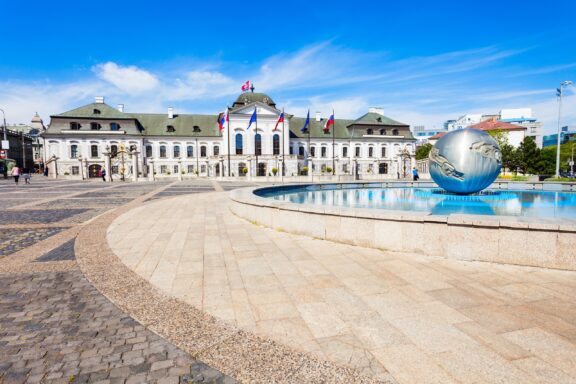
During World War II, Bratislava was declared the capital of the First Slovak Republic, a puppet state of Nazi Germany. The city’s Jewish population was heavily affected by the Holocaust.
After the war, Bratislava became part of the re-established Czechoslovakia. The city saw significant growth and industrialization during the socialist period, including constructing the New Bridge (Most SNP) and the Petržalka residential area.
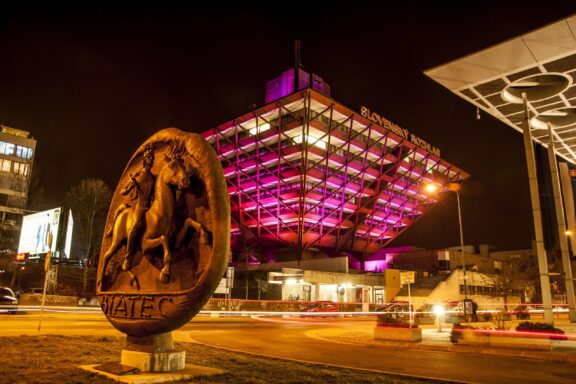
Since the Velvet Revolution in 1989 ended communist rule, mainly after Czechoslovakia split into the Czech Republic and Slovakia in 1993, Bratislava has flourished as the capital of independent Slovakia. The city has become an essential central European economic hub while restoring and preserving its rich historical sites.
Today, Bratislava is a city of contrasts, with historical buildings alongside modern architecture, reflecting the city’s vibrant history and contemporary growth.
Features of Bratislava
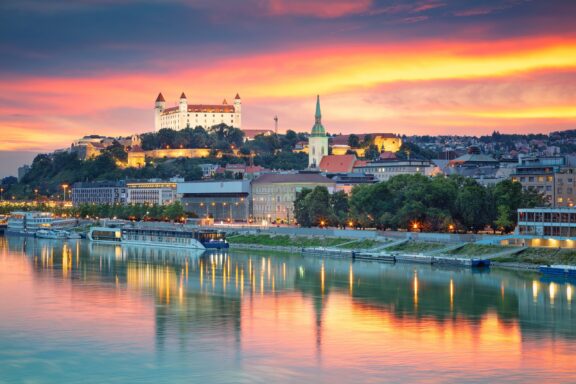
Bratislava, the capital of Slovakia, is an intriguing city that merges a storied history with a youthful, modern dynamism. Its most notable aspects range from impressive architectural landmarks and vibrant culture to rich culinary traditions.
The city’s architectural diversity is one of its most defining features. The city’s historic heart is a maze of charming cobblestone streets with pastel-colored baroque houses. Bratislava’s vibrant cultural scene is another notable feature. The city brims with museums, galleries, theaters, and the city’s street art scene adds a modern, creative touch to the urban landscape.
Geography and Climate
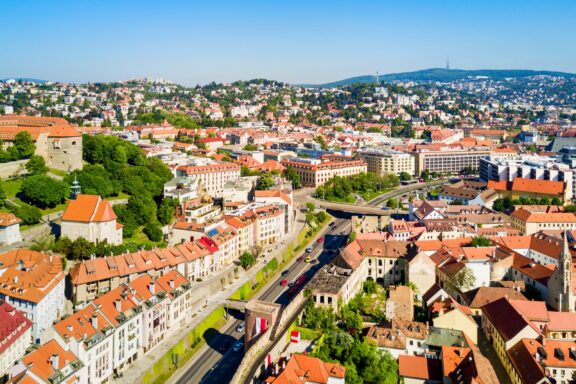
Bratislava lies on the foothills of the Little Carpathian Mountains, which flow into the lowlands of the Danube Plain. The city’s terrain is characterized by vineyards, forests, and the meandering Danube River, which plays a crucial role in the city’s landscape and economy. The Morava River, forming the border between Slovakia and Austria, also converges with the Danube near Bratislava.
The city has a temperate and continental climate with four distinct seasons. Summers can be hot, with temperatures often rising above 30 °C (86 °F), while winters can be cold, with temperatures dropping below 0°C (32 °F). The average temperature ranges from -2 °C in January (28 °F) to 21 °C (70 °F) in July. The city sees moderate rainfall throughout the year, with the highest concentration in the summer months.
Population
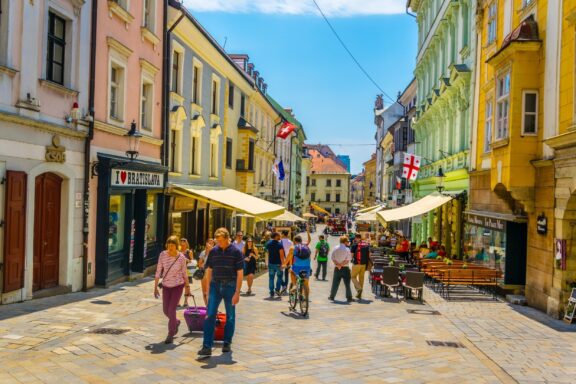
Bratislava has a population of approximately 600,000, making it the largest city in Slovakia. The city’s inhabitants are predominantly Slovak, but there is a diverse mix of other ethnicities, including Hungarians, Czechs, and expatriate communities worldwide.
The official language is Slovak, but English is the most foreign spoken language and Hungarian as well as German are also commonly spoken, especially in the city center and among the younger population.
Economy
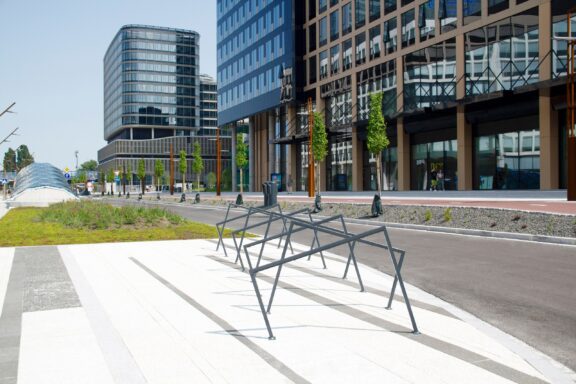
Bratislava is the economic powerhouse of Slovakia, contributing a significant portion of the country’s GDP. The city benefits from its strategic location in Central Europe, proximity to major cities like Vienna and Budapest, and well-educated workforce.
The city’s economy is diverse, with sectors like automotive manufacturing, information technology, financial services, tourism, and retail playing significant roles. Several multinational companies have regional headquarters or shared service centers in Bratislava, capitalizing on the city’s access to the broader European market.
The automotive industry is particularly significant. With Bratislava as a critical hub, Slovakia is one of the world’s largest per capita car producers, hosting factories of major automakers.
Information and communication technology is another vital sector, with Bratislava home to many tech startups and IT service providers. The city’s digital infrastructure and educated workforce make it an attractive location for technology firms.
Tourism is a crucial industry for the city. Bratislava’s rich history, architectural diversity, and vibrant cultural scene draw visitors worldwide. The Danube River plays a significant role, allowing river cruise ships to stop in the city.
Things to Do and Places to See in Bratislava
Bratislava boasts an abundance of activities and sights to explore. Let’s delve into some of the most sought-after landmarks and attractions this capital city offers.
1. Bratislava Castle
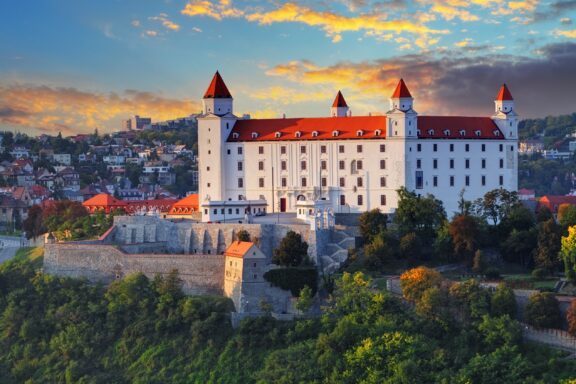
Bratislava Castle, also known as Bratislavský hrad in Slovak, is a large, prominent castle on a hill near the Danube River in Bratislava, the capital of Slovakia. The castle is a vital city symbol, with its distinct rectangular building and four corner towers offering commanding views of Bratislava and neighboring Austria and Hungary.
The history of the castle site spans back to the Stone Age, with evidence of continuous habitation. It has been home to Celts, Romans, and Slavs before becoming a political, military, and religious hub in the Middle Ages for the Kingdom of Hungary. Today’s castle building was mainly constructed in the 15th century, with significant reconstructions and renovations in later centuries.
2. Old Town
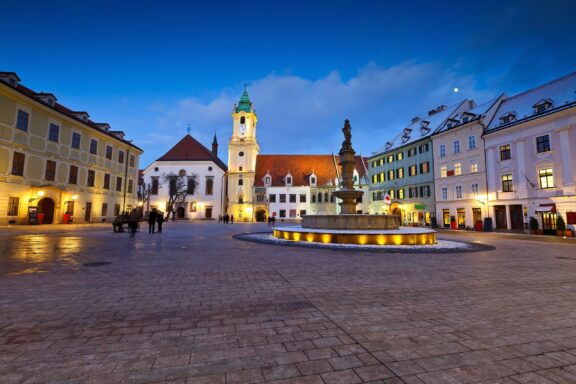
Bratislava’s Old Town, known as “Staré Mesto” in Slovak, is the historical center of Bratislava, the capital of Slovakia. Medieval buildings, narrow winding streets, and significant landmarks characterize this area. It’s the oldest and most historically significant part of the city.
Bratislava’s Old Town is also known for its numerous outdoor cafés, restaurants, and shops, and it’s a bustling area with lively nightlife. While exploring, don’t forget to look out for the various whimsical bronze statues around the Old Town, including the famous Čumil (the “Watcher”) and Schöner Náci, a local historical figure.
3. St. Martin’s Cathedral
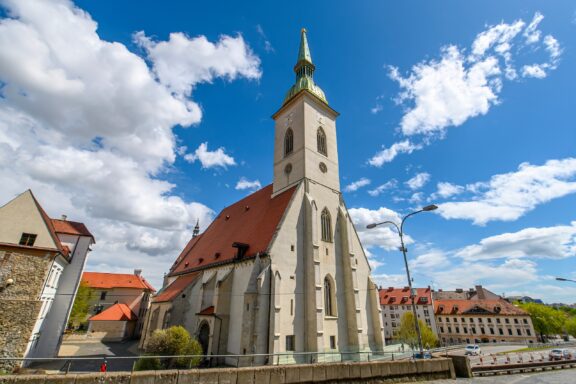
St. Martin’s Cathedral, known as “Katedrála svätého Martina” in Slovak, is one of the oldest and most significant churches in Bratislava. The cathedral is situated at the western border of the city’s historical city center, below Bratislava Castle, and its impressive 85-meter-high spire dominates the Old Town’s skyline.
The cathedral is significant in Central European history, primarily because it served as the coronation church for the Kingdom of Hungary between 1563 and 1830. During this period, 11 Hungarian kings and queens, including the famous Maria Theresa, were crowned in St. Martin’s Cathedral.
4. Blue Church (St. Elizabeth’s Church)
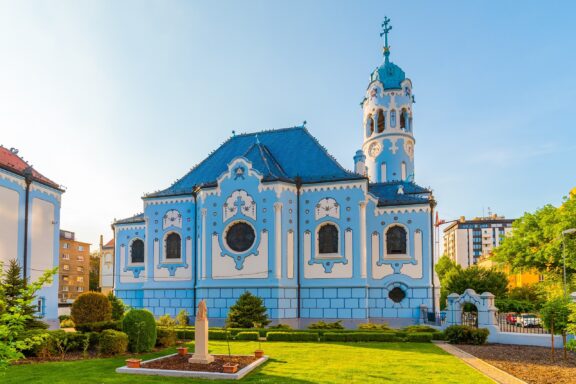
The Blue Church, officially named the Church of St. Elizabeth of Hungary (Kostol svätej Alžbety in Slovak), is an iconic Art Nouveau building located in Bratislava, the capital of Slovakia. Its nickname derives from its distinctive blue color scheme – the façade, mosaics, majolicas, and interior and exterior walls are all various shades of blue.
The Blue Church is characterized by its rounded forms and decorative elements, another characteristic feature of the Art Nouveau style. The church has a cylindrical three-level tower and a single nave. The interior and exterior are decorated with majolica tiles, a ceramic tile with an opaque glaze. A blue-glazed roof and blue-painted walls give the church its whimsical appearance, making it a favorite among visitors and photographers.
5. Michael’s Gate
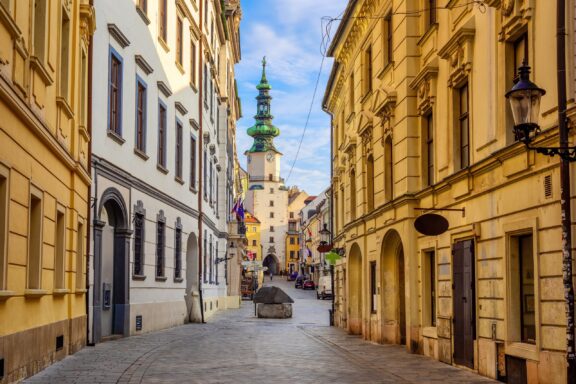
Michael’s Gate (Michalská brána in Slovak) is the only city gate preserved of the medieval fortifications in Bratislava, the capital of Slovakia. Named after St. Michael and the St. Michael’s Church that stood in front of it, the gate is one of the oldest buildings in the city.
The gate’s tower stands approximately 51 meters high and is capped with a statue of the Archangel Michael, slaying a dragon. The tower was used for centuries as a defensive feature and a toll place.
6. Devin Castle
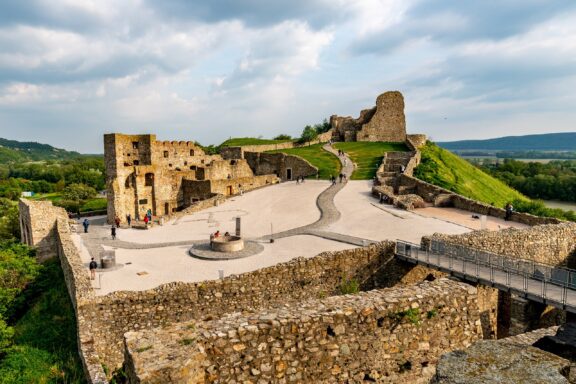
Devin Castle (Devínsky hrad in Slovak) is a historic castle located in Devín, a borough of Bratislava, the capital of Slovakia. The castle is perched on a cliff where the Danube and Morava rivers meet, which creates a spectacular natural setting and offers breathtaking views of the surrounding landscapes, including parts of Austria.
The castle has a rich history, with archaeological evidence showing that the site has been settled since prehistoric times. It was a significant fortification during the Roman period and later became an essential royal castle in the Kingdom of Hungary.
7. Slavín War Memorial
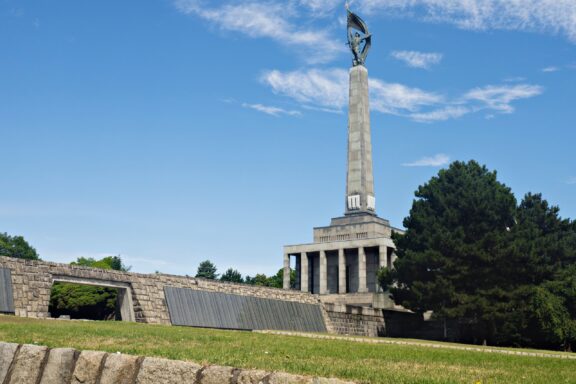
Slavín War Memorial, located in Bratislava, is a large memorial monument and military cemetery dedicated to the Soviet Army soldiers who lost their lives during World War II. Specifically, it commemorates the liberation of Bratislava in April 1945, when the city was freed from Nazi German control by the Soviet Red Army.
Constructed between 1957 and 1960, the memorial is situated on a hill in the city, offering a sweeping view over Bratislava. The monument’s central feature is a towering pylon topped with a giant statue of a Soviet soldier by sculptor Alexander Trizuljak, which stands at a total height of 39.5 meters. The soldier is depicted holding a flag and watching over the city below.
8. UFO Bridge (Most SNP)
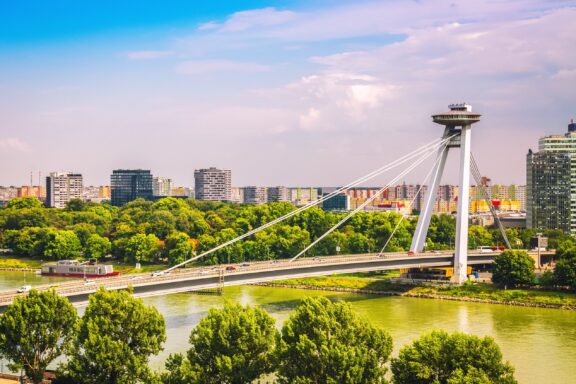
The Bridge of the Slovak National Uprising (Most Slovenského Národného Povstania), commonly known as the “UFO Bridge” and officially as “Most SNP,” is a distinctive landmark in Bratislava, the capital of Slovakia.
The bridge is an example of Communist-era architecture. It is a cable-stayed bridge across the Danube River, with a pylon on the left bank. Its unique design and the characteristic ‘UFO-shaped structure atop one of its pylons make it one of the city’s most recognizable landmarks.
9. Bratislava City Museum (Mestské múzeum)
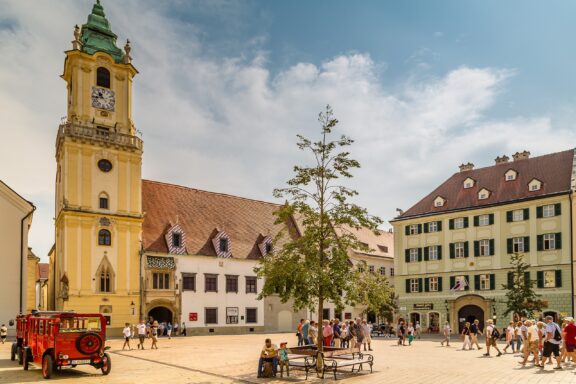
The museum is located in the Old Town Hall at the city’s Main Square, one of the oldest historic stone buildings in the country, with a history dating back to the 14th century. The Old Town Hall is a complex of buildings from different periods, and visiting the museum allows you to explore its historical rooms, Gothic cellars, and a tower with panoramic views of the Old Town.
The Bratislava City Museum features a variety of exhibitions that focus on the history of Bratislava, from the Middle Ages to the present day. It includes displays of historical artifacts, archaeological finds, coins, old weapons, paintings, and city models at various times. The museum also presents exhibitions about the town’s privileges, the history of its citizens, crafts, and viticulture.
10. Primatial Palace
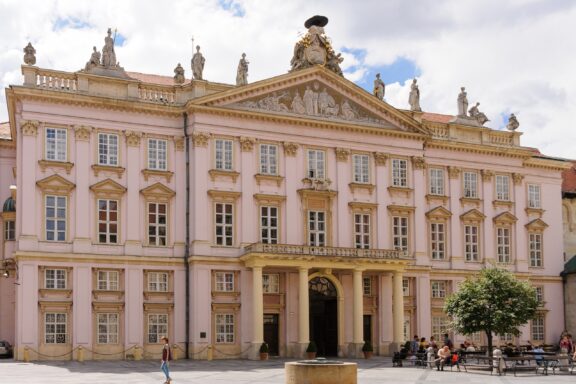
The Primatial Palace (Primaciálny palác in Slovak) is an elegant neoclassical building in the Old Town of Bratislava, the capital of Slovakia. The palace is one of the city’s architectural jewels, and it’s known for its beautiful pink façade, intricate detailing, and the Hall of Mirrors, which has witnessed important historical events.
Inside, the palace is just as grand, with several notable features. Perhaps the most famous is the Hall of Mirrors, a grand room where the Treaty of Pressburg was signed in 1805, marking the end of the War of the Third Coalition. The treaty was a significant moment in European history as it marked the end of the Holy Roman Empire and led to the rise of Napoleon’s influence in Europe.
11. Danubiana Meulensteen Art Museum
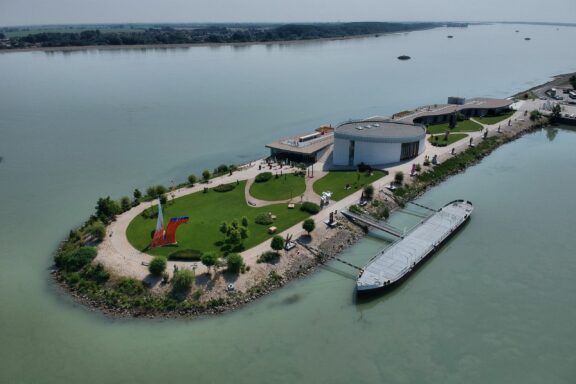
The Danubiana Meulensteen Art Museum is one of Slovakia’s most attractive modern art museums and arguably in Central Europe. Located about 20 kilometers south of Bratislava, the museum sits on a peninsula stretching into the Danube River, creating a unique interaction between the modern architecture of the museum, the surrounding natural environment, and the artwork it houses.
The Danubiana Meulensteen Art Museum exhibits works from both Slovak and international artists. Its collection includes a broad range of modern and contemporary visual arts, with exhibits ranging from painting and sculpture to installations and video art.
12. Slovak National Theatre
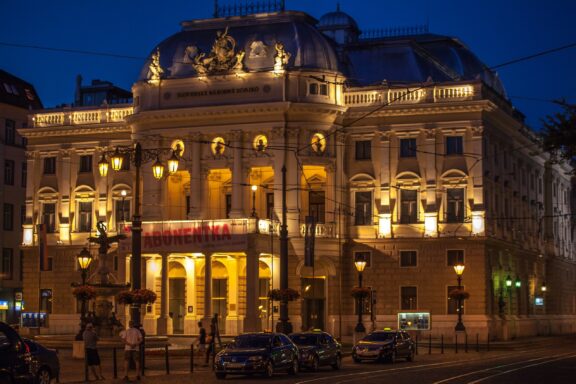
The Slovak National Theatre (Slovenské národné divadlo in Slovak) is the oldest professional theatre in Slovakia, with a rich history dating back to the late 19th century. It comprises drama, opera, and ballet sections and has been influential in developing and promoting Slovak performing arts.
The theatre is a significant cultural institution in Slovakia and plays a vital role in the country’s performing arts scene. It offers various performances throughout the year, including classic and contemporary works, often with Slovak and international artists.
Frequently Asked Questions
What is the best time to visit Bratislava?
The best time to visit Bratislava is spring (April to June) and fall (September to October) when the weather is mild and the city is less crowded. If you don’t mind the heat and enjoy a bustling atmosphere, the summer months (July to August) offer numerous cultural events and festivals.
Is it safe to visit Bratislava?
Thanks to its relatively low crime rates, Bratislava is typically deemed a secure destination for travelers.
What is traditional food and cuisine like in Bratislava?
Traditional Slovak cuisine in Bratislava is hearty and rich, featuring dishes like:
• Bryndzové halušky (potato dumplings with sheep cheese)
• Goulash (a stew of meat and vegetables)
• Zemiakové placky (fried potato pancakes).
What’s a must-try dish/food in Bratislava?
You should definitely try Bryndzové halušky. It’s the national dish of Slovakia and is beloved by locals.
What souvenirs can I bring home from Bratislava?
Popular souvenirs from Bratislava include locally made ceramics, Slovak wines, traditional dolls, Modra pottery, and Slovak honey or honey liquor.
How can I get around in Bratislava?
Bratislava has an extensive public transportation system, including trams, buses, and trolleybuses. The Old Town is compact and perfect for exploring on foot. Taxis and rideshare services like Bolt are also available.
Is it expensive to visit Bratislava?
Compared to many Western European cities, Bratislava is quite affordable, with lower costs for dining, accommodation, and attractions. However, prices can vary depending on personal spending habits and preferences.
Which currencies are accepted in Bratislava?
The official currency of Slovakia is the Euro (€). Credit cards are widely accepted in most places as well.
Is Bratislava a good city to live in?
Bratislava offers a high standard of living with its rich history, vibrant culture, excellent public transportation, and accessibility to other major European cities. It also has a growing economy with job opportunities, particularly in the tech industry. However, the quality of life can depend on personal factors like employment, lifestyle preferences, and language proficiency.
Is it safe to drink tap water in Bratislava?
Yes, tap water in Bratislava is safe to drink.
Which cultural customs should I be aware of when visiting Bratislava?
Slovak people value politeness. It’s common to greet with a firm handshake and maintain eye contact. When dining, waiting for the host to start eating before you begin is customary.
How can I respect the local culture and environment during my visit to Bratislava?
You can respect the local culture by learning a few basic phrases in Slovak, adhering to local customs, and respecting historical sites and monuments. Respect the environment by following local regulations, disposing of trash properly, and minimizing your footprint wherever possible.
Final Thoughts
Bratislava is undoubtedly worth visiting with its rich history, architectural diversity, and vibrant culture. Its unique blend of medieval charm and modern energy, combined with its compact size, makes it an accessible and intriguing destination for tourists. From exploring the historic Old Town to experiencing its contemporary art scene and culinary delights, the city has something to offer everyone.
Its location on the Danube River and proximity to other major European cities further enhance its appeal. Whether for a short city break or an extended stay, a visit to Bratislava provides a captivating glimpse into the heart of Central Europe.
Image Sources and Copyright Information
- Red Pin on Bratislava Map Location: © JoaoCachapa/Shutterstock
- Grassalkovich Palace with Globe Sculpture in Foreground: © saiko3p/Shutterstock
- Illuminated Slovak Radio Building at Night: © Lubos Houska/Shutterstock
- Bratislava Skyline at Sunset: © Rudy Balasko/Shutterstock
- Aerial View of Bratislava Cityscape: © saiko3p/Shutterstock
- Bustling European Street Scene with Pedestrians and Shops: © trabantos/Shutterstock
- Modern Urban Financial District with Office Buildings: © Anna Linda Knoll/Shutterstock
- Bratislava Castle at Sunset: © TTstudio/Shutterstock
- Evening View of Bratislava Old Town Square: © Milan Gonda/Shutterstock
- St. Martin Cathedral against Blue Sky: © Mitzo/Shutterstock
- Blue Church in Bratislava: © Kayo/Shutterstock
- Cobbled Street Leading to Michael’s Gate in Old Town: © Boris Stroujko/Shutterstock
- Devin Castle Ruins and Courtyard: © AlexelA/Shutterstock
- War Memorial Monument under Blue Sky: © Zuzana Krajcir/Shutterstock
- UFO Bridge Over River in Bratislava: © Yuliya_P/Shutterstock
- Old Town Square with Historical Museum Building: © Vivida Photo PC/Shutterstock
- Baroque Style Palace Facade: © Michael Paschos/Shutterstock
- Aerial View of Danubiana Meulensteen Art Museum: © AeroScantech/Shutterstock
- Illuminated Facade of the Slovak National Theatre at Night: © Jaroslav Moravcik/Shutterstock